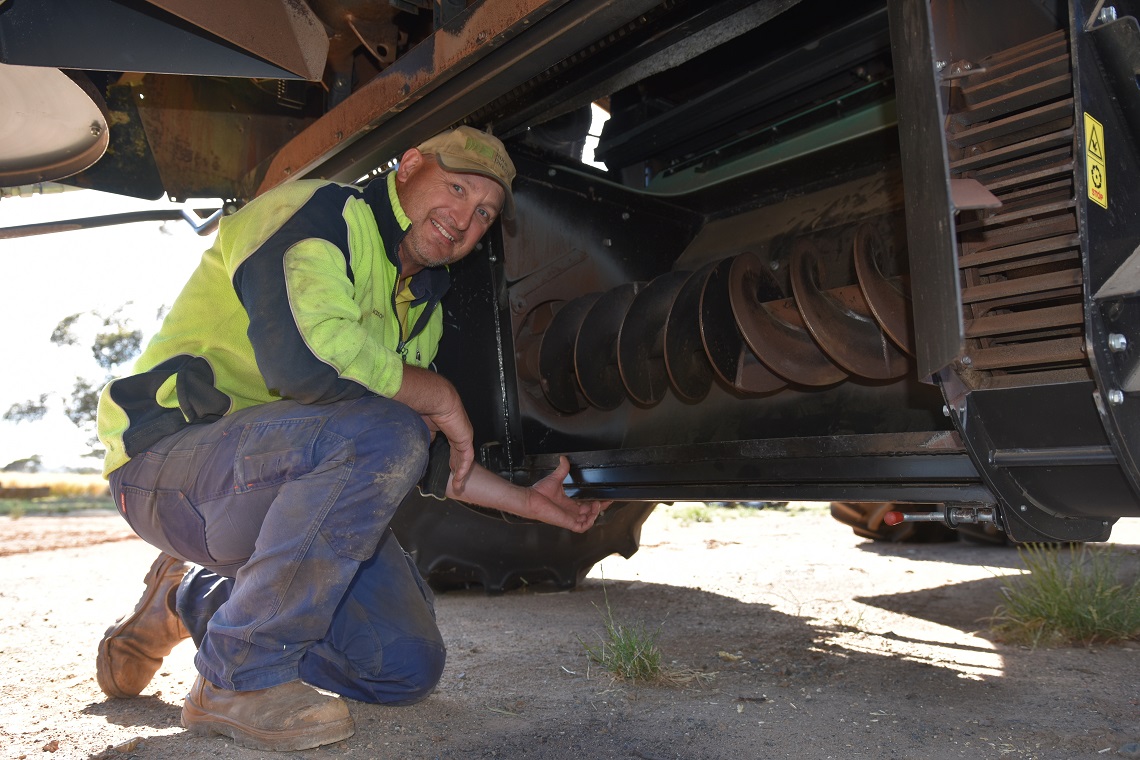

12 January 2022
PARETA Farms in the Lower North has taken a liking to Western Australian inventions for harvest weed seed management, with its latest move involving the adoption of a fully harvester-integrated system.
It’s not surprising considering the herbicide-resistant weed populations that exist in long-running continuous cropping programs in WA, particularly of annual ryegrass and wild radish. This has prompted a strong focus on mechanical methods of weed seed control, as part of using the full range of tools in the weed control “toolbox’’.
Owned by Pinion Advisory, formed last year following the merger of three leading rural consultancies, Pareta Farms grows wheat, barley, canola, lentils, faba beans and oaten hay over 750 hectares, including leased and share-farmed land, near Freeling. It also provides a contract harvesting service in the local area, adding around another 650ha to their harvest program.
The farm sits in a 400-millimetre rainfall zone and features Bay of Biscay black clay through to red clay soils, as well as some sandy loams with red clay underneath.
Farm Operations Manager Jason Henschke, who started as Farm Operations Assistant at the property 14 years ago, said the main crop rotation included a pulse or canola break crop, also for nitrogen fixation, followed by wheat and then barley, the latter providing good crop competition against weeds.
Similar to WA growers, ryegrass and radish are presenting the major weed challenges, while bifora and bedstraw are developing and weeds like fleabane and feathertop Rhodes grass have emerged since the 2015 bushfires in the region.
A range of herbicides are applied against the weeds as part of a double knock, upfront spraying strategy, pre-emergent applications, spray-topping and spraying under canola and occasionally faba bean windrows.
“We do everything we can to get crops going the best we can, but depending upon early conditions and weed germinations, we can be dealing with a strong weed population in-crop,’’ Jason said.
“If the weed situation gets bad, we may do two years of hay on some paddocks. We are fortunate to have export hay operators nearby, although variation with what they accept can be a challenge.’’
Mechanical weed seed control at harvest and the link to WA machines started around 2011 with the attaching of the Bale Direct System to their harvester for constructing bales of chaff and straw material.
Jason said the system was used for several years before adding a second harvester then presented an issue.
Pareta Farms has since reverted to operating one header, now integrated with the Harrington Seed Destructor after monitoring the development of the system and other similar machines over a number of years.
Invented by WA grower Ray Harrington and independently shown to kill up to 99 per cent of weed seeds, the Seed Destructor is designed and manufactured by de Bruin Engineering and distributed nationally by McIntosh Distribution. The core mill technology was developed by UniSA with funding and support from GRDC.
“When the [Seed Destructor] design was simplified, there was the change to the vertical mills and it became more affordable, we decided let’s get into it and add another tool.
“We did look at other systems, but the simplicity of the Seed Destructor won over. It is a lot simpler. There are no extra gearboxes, no other shafts to run that others have got – and the others have only got horizontal mills.’’
Sourced from Ramsey Bros at Riverton, the Seed Destructor has completed two successful harvests on the New Holland CR 9.90 harvester at Pareta Farms
“It spins at 3000 RPM all day and we haven’t had any issues,’’ Jason said.
“We harvest at full noise and our ground speed and header capacity is still the same as though we are harvesting normally. There might be a tiny bit of horsepower drag, but it’s not a limiting factor. Our limiting factor has been the stubble load with our draper front and cutting at beer can height.
“We had a little bit of build-up with canola, but nothing too major or that stopped it, and we wait until lentils are completely ready. There were no concerns over rotor or sieve losses.’’
He said they were satisfied to clock 500-600 rotor hours with the first set of mills on the Seed Destructor.
“Given the big season we had last year, we were not fussed at all.’’
Some of the crop yield averages at Pareta Farms last season included 5-6 tonnes/ha for wheat, 3-4t/ha for lentils and 2.5-3t/ha for canola.
Jason said the stone trap at the bottom of the Seed Destructor was a fantastic feature.
“We routinely drop it. Anything that is heavy enough sinks down through the chaff into the trap.’’
He said it was vital to add a mechanical method back into the weed management program and there was strong confidence in the high weed seed kill rates with the Seed Destructor.
“We have noticed compared with other paddocks in the district that ours are hardly getting green with volunteers.’’
“We think it’s driving the weed seed bank down. It’s still there, but this is giving us every chance to reduce seed numbers.’’
Jason said he also was impressed with the service and support for the new system from Ramsey Bros at Riverton.
“If the system has any upgrades, they are done, and if anything is out of place, it is just a phone call and they are here,’’ he said.
In addition to New Holland harvesters, the Seed Destructor can be fitted to later model Case IH, John Deere and Claas headers, with no permanent modifications required.
Growers interested in further information about the vertical, mechanical Harrington Seed Destructor can contact their local dealer.